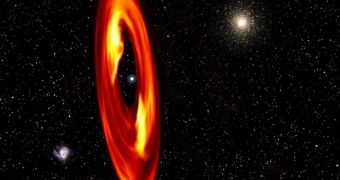Scientists say that it takes less time for a planet to form, than for it to completely cool down and compose a solid crust. The study was based on the small meteorites, which occasionally land on the Earth's surface. Physicists from the Lunar and Planetary Institute in Houston, Texas, UC Davis and NASA, found that for a planet the size of Mars, it takes about 100 million years to cool its ocean of molten rock resulted in the process of planetary formation.
The solar system was created about 4.5 billion years ago. The time needed for planets to form, out of an accretion disk swirling around a star, it takes somewhere between 10 to 50 million years. Qing-Zhu Yin, one of the authors of the paper presenting the discovery, thinks that the metallic core of the Red Planet formed only a few million years after the birth of the Sun. Previous studies regarding the time it takes for the molten surface to create a solid crust estimated the values somewhere in the range of a few thousands years to several million years.
The fact that Mars might have remained so hot over long periods of time suggests that it must have had a really thick atmosphere to insulate the molten surface from the coldness of space. Earth receives about five percent of all the matter thrown off the Martian surface, by a different asteroid impact which spewed rocks that had enough energy to escape its gravitational field, and were captured by Earth in a kind of sample return mission carried out by nature. By studying these meteorites that fell on the surface of our planet over time, they were able to determine the proportions of neodymium and samarium isotopes to calculate the ages of the meteorites, and to determine what was the Martian crust billions of year before they were 'ejected'.
According to Yin, planets form in three stages. The dust cloud circling the Sun, first collected objects with diameters of a few kilometers across, after which these objects fall towards each other and collide, under the action of their gravitational field, to form larger objects the size of Mars or the Moon. It the final stage of planet forming, these objects may eventually collide to create planets the size of Earth or larger.
Large amounts of energy result in the process, creating heat which would have nowhere to go, except into the mass of the newly formed planet. The heat melts the rock to molten magma, which separates the heavy element, sinking under the influence of gravity to its center to create a compact core which will result in even more energy. As the planet's core slowly cools down, the molten mantle of silicate will also cool down to form a solid surface, floating on a sea of hot magma.

 14 DAY TRIAL //
14 DAY TRIAL //